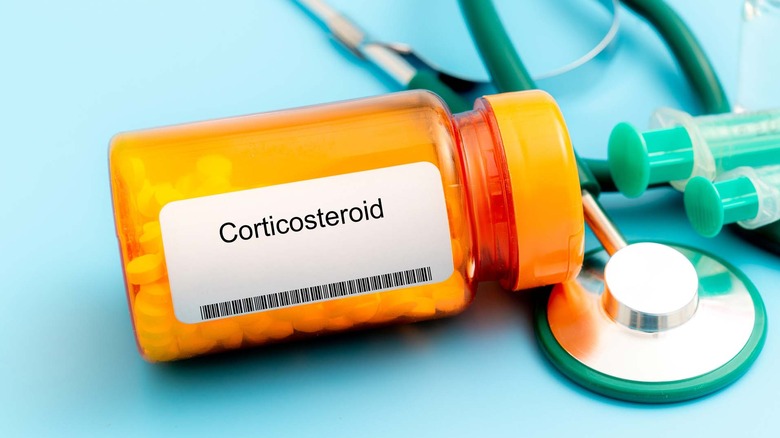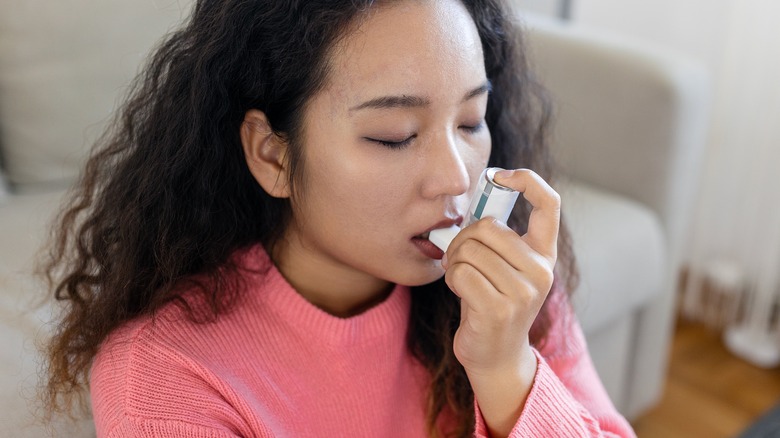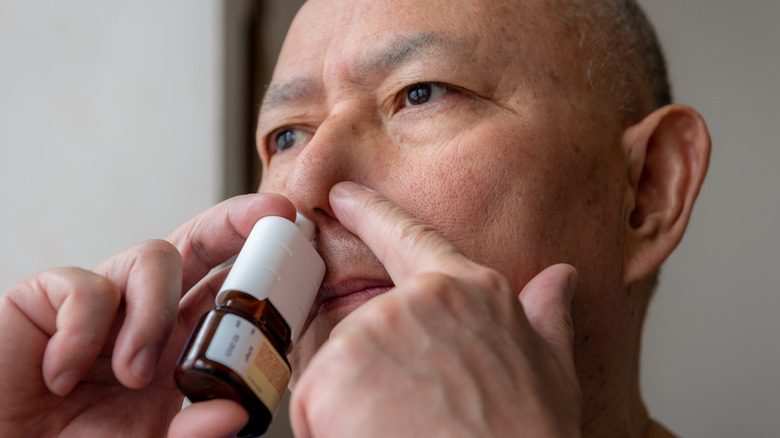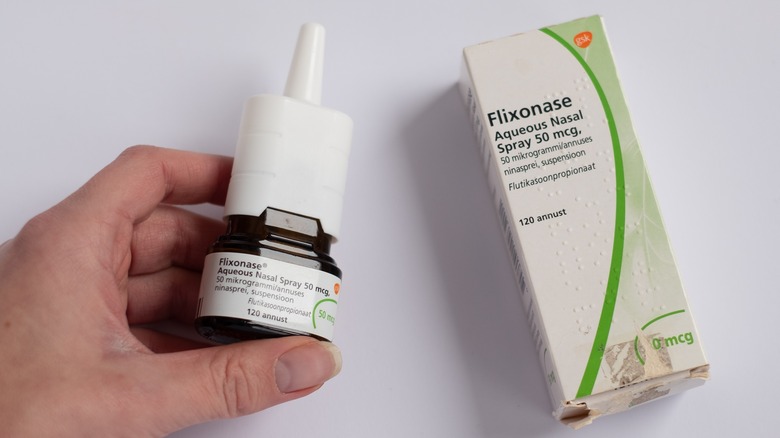Fluticasone Explained: Usage, Dosage, And Side Effects
Fluticasone is both a prescription and an over-the-counter medication classified as a corticosteroid. Most commonly, fluticasone is prescribed to treat common allergies, allergy symptoms, and asthma. When it enters the body, fluticasone works quickly to decrease inflammation, which is what typically occurs when someone experiences a reaction to an environmental allergen. It also helps to open up airways that can become inflamed or restricted due to allergies or asthma and decreases mucus that gets in the way of clear airways (per Fluticasone).
The U.S. Food & Drug Administration (FDA) approved fluticasone to be sold over-the-counter in 2016, for use by adults and children age 4 and over to combat symptoms the respiratory symptoms of allergies. You might know the over-the-counter version as Flonase, which comes in a few varieties, such as a lower dosage for children and a pill form for nighttime allergy relief.
If you've recently been prescribed fluticasone and want to learn more about it, continue reading this guide to learn more about its intended usage, dosage, and possible side effects. As always, be sure to talk with your doctor about the best options for you and your health.
What is a corticosteroid?
A corticosteroid — the class of drugs that fluticasone falls into — is a type of medicine designed to mimic a regular bodily process. Also known as steroids, they're usually given as a prescription but can sometimes be available as over-the-counter medications, like Flonase, in the case of fluticasone. Steroids commonly are used to treat respiratory ailments, such as asthma and upper respiratory symptoms from allergies per the National Health Service (NHS), which is also the main purpose of fluticasone. Prednisone is another common steroid you might have heard of that can also treat problems similar to those that fluticasone combats, like asthma and allergies, according to the Mayo Clinic.
Some manufacturers mix the corticosteroid fluticasone with other types of medications to treat specific conditions, symptoms, or allergies. While the steroid goes to work on inflammation, the other medicine additions — such as antihistamines — can do what they do best at the same time (per NHS). Your doctor can explain the type of medicine they suggest or prescribe so that you know exactly what's in it and what each ingredient does.
Fluticasone is available as an inhaler or nose drops
Perhaps the most common form of fluticasone is nasal spray, which comes in a bottle with a spray nozzle that users can squirt into each nostril. The spray is designed to work quickly to clear blockages within the nostrils and airways, especially when caused by inflammation or mucus. However, fluticasone nose drops are also available by prescription only, and they're most effective in treating nasal polyps (per NHS).
You can also get a prescription for a fluticasone inhaler to reduce asthma symptoms. According to the NHS, fluticasone inhalers work to reduce the likelihood of having a severe asthma attack once you start experiencing symptoms. Fluticasone can also be in a nebulizer form, which you breathe in with a mask. It works similarly to an inhaler, but a nebulizer is usually reserved for more severe cases of asthma. Both the inhaler and nebulizer versions are usually prescribed for everyday usage so that you get consistent dosing of the steroid, although people may be prescribed different strengths.
Fluticasone spray treats these allergy symptoms
Fluticasone can improve inflammation caused by allergies and allergy symptoms. When inflammation decreases, some allergy symptoms can also improve. Therefore, there are several symptoms you get from seasonal allergies that you should notice getting better with regular fluticasone usage. Seasonal allergies tend to cause symptoms like a runny nose, sneezing, coughing, and itchy eyes, nose, and throat.
Fortunately for allergy sufferers, fluticasone can tackle many of the symptoms caused by seasonal allergies, and it may also reduce symptoms from environmental allergies caused by things like pet dander and dust (per WebMD). GoodRx explains that these symptoms, as much of a nuisance as they can be, occur to rid your body of the irritants causing your allergic reaction. However, when that happens, the immune process can cause all kinds of unwanted symptoms that usually attack your respiratory system. But thanks to fluticasone, you could find some relief from these chronic allergy symptoms.
Fluticasone inhalers can also treat COPD
Fluticasone inhalers are commonly prescribed for people with asthma, but they can also come in handy as preventative inhalers for people with chronic obstructive pulmonary disease, also known as COPD. People with COPD have chronic inflammation of their airways, making it difficult to breathe (via the Mayo Clinic). The condition causes frequent wheezing and coughing, and people with it may also produce more mucus than usual.
A fluticasone inhaler is one possible treatment method for people with mild to moderate COPD. In more severe cases, a doctor may prescribe a fluticasone inhaler instead. For COPD, regular usage is just as important as it is for asthma because it typically takes a few days for people to see improvements in their symptoms after beginning a fluticasone treatment, according to the NHS. Still, fluticasone is far from the only treatment option for COPD. Doctors might also prescribe bronchodilators, oral steroids, or fluticasone or another steroid mixed with additional medications (per the Mayo Clinic).
Fluticasone can also be used for non-allergy symptoms and nasal polyps
Most people use fluticasone to treat their allergy symptoms. However, many allergy symptoms, like sneezing and a runny nose, can also be present in people who don't have allergies. Because fluticasone works on the symptoms allergies cause, it may also relieve some of these symptoms when they're not caused by allergies. Still, the Mayo Clinic warns that it's still important to consider what might be causing those symptoms, like a cold, so that you can get the proper treatment for your specific condition.
Another problem fluticasone can help is nasal polyps, which are growths that appear on the lining of your sinuses. People with allergies or chronic respiratory problems could get nasal polyps from the consistent irritation and inflammation they experience. According to the NHS, fluticasone can actively shrink nasal polyps so that they don't create as much of an obstruction in your nasal passages. Usually, doctors prescribe fluticasone drops for this purpose.
How to use fluticasone spray
Fluticasone spray is available in different strengths and brands, so it's best to follow the specific instructions on the product's label or instructions given to you by your doctor or pharmacist. If you're not sure how to use the nasal spray, be sure to call your doctor or pharmacist first to ensure you're getting the medicine into your body the right way.
In most cases, you'll need to prime the spray bottle first by pumping it several times until the spray comes out (per the Mayo Clinic). After that, the spray should come out easily when you use the pump. Before spraying, blow your nose to rid your nostrils of any excess debris that could prevent the spray from getting into your airway. Then, close one nostril and insert the tip of the nozzle into the other nostril, pumping one spritz into the nostril as you breathe it in. Repeat on the other side. Clean off the bottle's nozzle before placing the cap back on.
How to use a fluticasone inhaler
Just like fluticasone nasal spray, a fluticasone inhaler comes in various brands, each of which may have distinct directions to follow for proper use. Again, it's best to check with your doctor or pharmacist if you're not sure you're using yours correctly.
Generally, fluticasone inhalers do not need to be primed first (via the Mayo Clinic). When you're ready to use yours, you can open the cap to expose the fluticasone inside. Directly before using the mask to breathe in the medicine, breathe out as much air as possible so that you can get a deep breath. Then, close your mouth around the mouthpiece, ensuring that your tongue doesn't block the air from getting into your mouth. Breathe in deeply and hold your breath for about ten seconds to let the medicine get into your airways. Close the cap to keep the medicine from continuing to release, and clean the mouthpiece. The Mayo Clinic also suggests rinsing your mouth with water after use to prevent irritation.
How much fluticasone should you take?
Generally, both children and adults can take fluticasone, although some products may not be recommended for children younger than two. Of course, dosing requirements varies between children and adults, too. The Mayo Clinic notes that specific brands and nasal spray products of fluticasone have dosing requiring just one spray in each nostril, while others suggest using two in each. In most cases, though, you only need to use fluticasone nasal spray once per day.
For a fluticasone inhaler, the dosage can vary significantly based on the severity of your asthma and why you need your inhaler. For instance, some people use an inhaler for regular maintenance to treat asthma and may need a regular twice-per-day dose of up to 232 mcg. Those who use fluticasone inhalers for prevention typically only start out with a smaller dosage of fluticasone twice daily, which is monitored and adjusted by their doctor as necessary (per the Mayo Clinic). Be sure to let your doctor know any symptoms you still have while using fluticasone in any form so they can make the proper adjustments.
Common side effects of fluticasone
Many medications have the potential to bring side effects, and fluticasone is no exception. Fortunately, more common side effects from fluticasone aren't usually very severe, and they typically only affect your nose and throat. For instance, some of the most common side effects are a sore throat, bloody nose, and a stuffy or runny nose. Some people may also experience more sinus-focused problems, like puffiness or tenderness in the cheeks or under their eyes, and headaches.
Also commonly reported are tightness in the chest, muscle aches, difficulty breathing, fatigue, and an overall feeling of weakness. Some people might also have stomach upset or vomiting after taking fluticasone, regardless of whether they use the nasal spray or inhaled version.
Although these side effects are the most common ones reported for fluticasone, you should still be sure to tell your doctor if you experience any of them, especially if they interfere with your everyday life. Your doctor might decide that lowering your dosage or switching you to a different medication is a better solution for you.
Severe side effects of fluticasone
Fluticasone is generally safe for most people to take, but there's always a chance that more serious side effects will occur that require medical intervention. Some of these include wheezing, thick nasal discharge, respiratory tract hoarseness, and a rash. Some people also experience slow-healing wounds and signs of infections, like a sore throat and fever, when taking fluticasone.
Even rarer is actually contracting a yeast infection in the throat, mouth, or nose. Dizziness, nose ulcers, a change in smell or taste, vision changes, mouth pain, back pain, or weight gain after using fluticasone spray or an inhaler could also indicate that something is wrong.
Most importantly, watch for signs of an allergic reaction, especially if you're using fluticasone for the first time. Symptoms of an allergy include swelling of the face or throat, trouble breathing, wheezing, a rash, and itchiness. If you think you're experiencing an allergic reaction to fluticasone, seek emergency medical help immediately.
Some people should ask their doctor before taking fluticasone
As with any medicine, fluticasone won't be the best choice for everyone. Some people with certain conditions, for example, may need to steer clear of fluticasone or ask their doctor if they're unsure whether it's safe. WebMD lists several conditions that may not cooperate well with fluticasone, including wide-angle glaucoma, eye pressure, active or inactive tuberculosis, and nasal septum ulcers. Some surgeries involving the sinuses or nose may also make fluticasone unsafe to take.
Long-term use is also something to discuss with your doctor. Although fluticasone is likely safe to take long-term in most cases, the Cleveland Clinic says that some doctors prefer to advise their patients to use the drug only as needed rather than every day. And, regardless of how often you take it, you should only use the lowest dosage needed to avoid adverse side effects. If you're concerned about daily, long-term usage of fluticasone, be sure to discuss your concerns with your doctor.
Drug interactions with fluticasone
People should also be mindful of other medications they take if they're prescribed fluticasone, which is why it's crucial to give your doctor a list of all your current drugs and supplements. For example, fluticasone can interact with some antibiotics that you'd take for bacterial infections, like clarithromycin, and medications you'd take for fungal infections, like ketoconazole. There's also a chance of drug interactions with HIV medications and some vaccines (via the Cleveland Clinic).
The Mayo Clinic also notes that there are several medications that are generally not recommended to use in conjunction with fluticasone, but in some cases, doctors may find it necessary to combine them. These include itraconazole, ritonavir, and bupropion. If you take a potentially interacting drug, your doctor may decide to take you off of it so that you can start fluticasone, or they might still prescribe both together but change the dosing. Either way, be sure to let your doctor know if you start taking anything else, like over-the-counter medication, or if you experience any side effects after beginning both medications.
Can pregnant and breastfeeding women take fluticasone?
According to the American College of Allergy, Asthma & Immunology, about 1% of pregnant women has asthma during their pregnancy, and it's even more common to have allergies while pregnant. Of course, pregnant women generally have to be more careful of the medications they take, as not all drugs are safe for unborn babies.
Fluticasone is mostly considered safe for pregnant women, and, according to the NHS, it may be prescribed more routinely for women with asthma to help control their symptoms, as breathing troubles can be dangerous while pregnant. Breastfeeding women may also be given the green light to use fluticasone. However, your doctor is ultimately the one who knows your medical history best and can determine a dosage that makes sense for you and your soon-to-be baby. In other words, don't skip a doctor's visit to get over-the-counter fluticasone if you're pregnant or breastfeeding, as you'll want to make sure you're getting the safest dose and the right form of fluticasone for your symptoms.
Stay away from grapefruit when taking fluticasone
There's one more thing to consider if you're going to start a regimen of fluticasone: whether you enjoy eating grapefruit or drinking its juice. It may sound odd, but grapefruit can interfere with several medications, including fluticasone. WellRx lists the potential interaction between grapefruit and fluticasone as major. It notes that the side effects you might experience from fluticasone can be heightened by grapefruit or grapefruit juice.
Why does grapefruit have such an odd effect on fluticasone and other medications? The FDA explains that grapefruit juice interferes with the body's natural process to break down medications in the body with the help of a specific enzyme. Grapefruit can prevent that enzyme from doing its job, which can cause the medication to build up in your system. What you could experience from fluticasone, then, is an extra supply of the medicine in your bloodstream, which may worsen any side effects you have with the drug.















